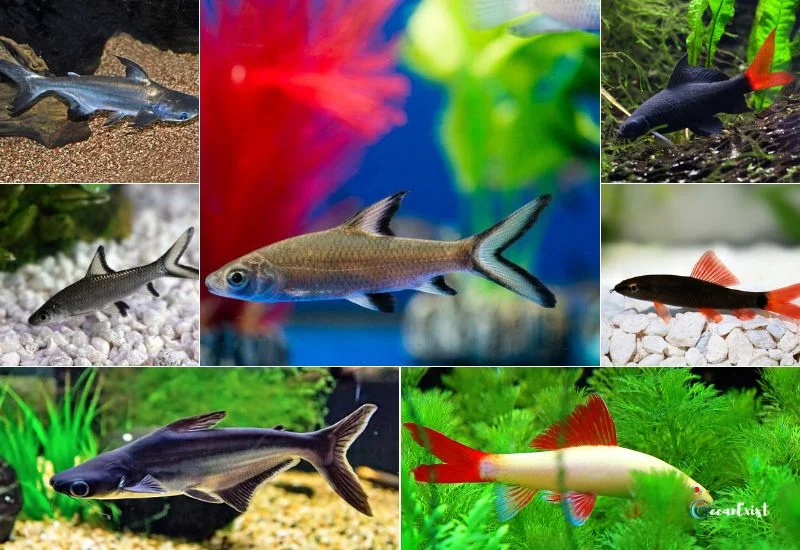If you are looking to add some entertainment to your home aquarium, consider keeping aquarium sharks. Freshwater sharks are not true sharks and belong to the Cyprinidae family. But they are given this name due to their appearance.
Aquarium sharks have sleek designs, torpedo-shaped bodies, and pointed fins. Usually, beginner aquarists love to have a freshwater shark due to their beautiful appearance and ease of care.
But they can grow much bigger in adulthood. So, We have curated a complete guide on the characteristics, physical care, and required environment for different types of aquarium sharks.
17 Marine Aquarium Sharks
Here are the top 17 marine aquarium sharks with their scientific names, size, care, diet, and more.
Rainbow Shark
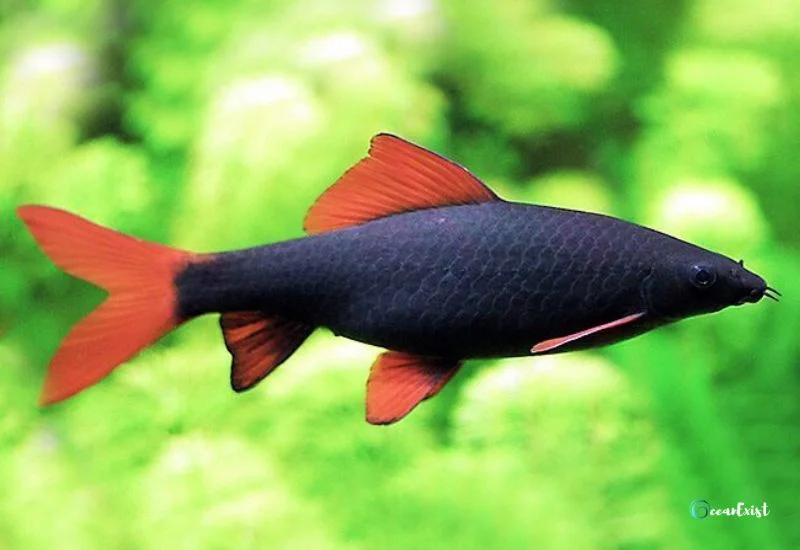
Rainbow sharks are relatively small in size and may be kept in a smaller tank. They are herbivorous and omnivorous in nature and eat algae in the form of flakes.
They are very aggressive in nature and cannot be kept with other fish species in the tank. Instead, You can keep fish species that can defend themselves against the aggression of Rainbow fish.
- Scientific name: Epalzeorhynchos frenatum
- Size: 6 inches
- Food and Diet: Omnivores
- Temperament: Aggressive
- Lifespan: 4-6 years
- Origin: Mekong, Chao Phraya and Maeklong in Indochina
- Required Tank Size: 50 Gallons
- Difficulty to breed: Advanced
- Temperature: 68-79° Fahrenheit
- Water pH: 6.5-8.0
- Water Hardness: 5-15 dGH
Bala Shark
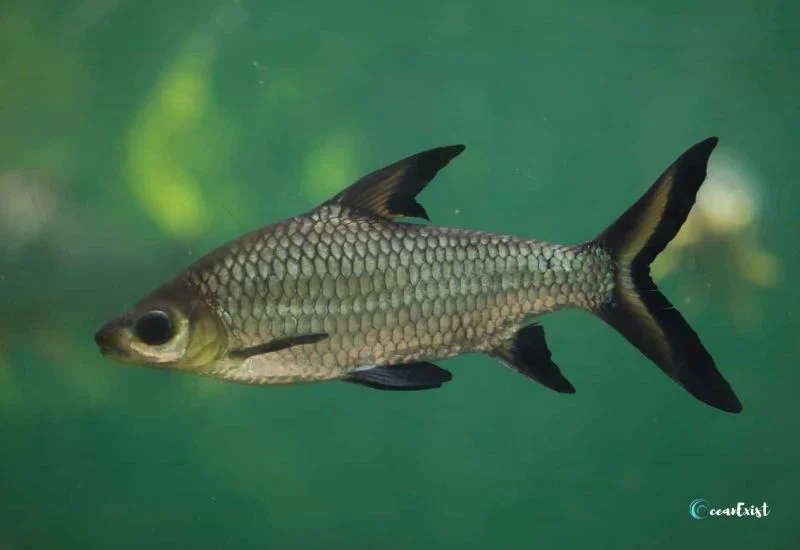
The Bala sharks are considered gentle giants of their personality. They are also known as tricolor sharks or shark minnows. Bala sharks are very active and spend most of their time swimming.
They exhibit a very schooling behavior when they are in a group. They are not very hardy and require moderate freshwater conditions. They are very easy to care for in a captive environment.
- Scientific name: Balantiocheilos melanopterus
- Size: 10-13 inches
- Food and Diet: crustaceans, insects and larvae
- Temperament: Peaceful
- Lifespan: 10 years
- Origin: Southeast Asia
- Required Tank Size: 125 Gallons
- Difficulty to breed: Intermediate
- Temperature: 77° Fahrenheit
- Water pH: 6.5-8.0
- Water Hardness: 5-15 dGH
Red Tail Shark
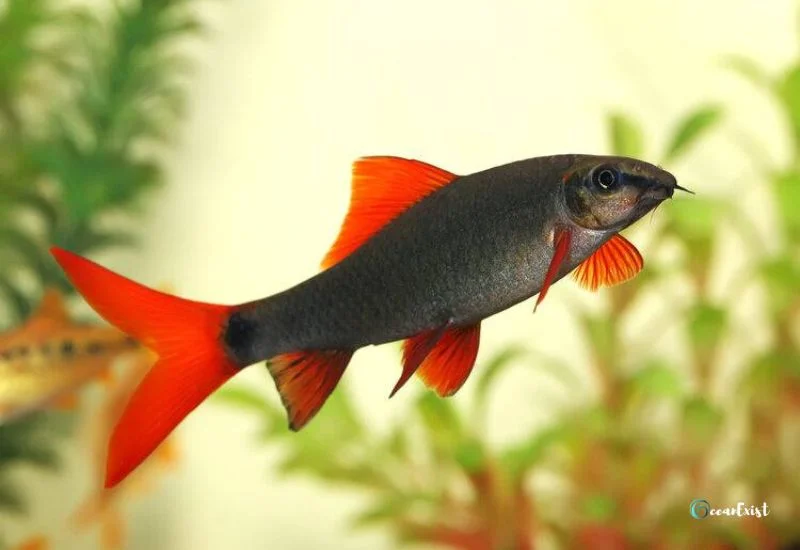
They are also known as Red-tail black sharks. They have red fins on their tail and have resemblance with Rainbow sharks. They originally belong to freshwater lakes in Thailand.
If you are a beginner aquarist, do not try to breed Red-tail at home because it required special water conditions and advanced methods for breeding.
The Red-tail sharks are very territorial and need a special aquarium space for themselves. If you want to bring tank mates for Red-tail sharks, make sure they can defend against aggressive behavior and do not involve much in fighting, especially over food.
- Scientific name: Epalzeorhynchos Bicolor
- Size: 6 inches
- Food and Diet: crustaceans, insects and larvae
- Temperament: Semi-aggressive
- Lifespan: 10 years
- Origin: Thailand
- Required Tank Size: 65 Gallons
- Difficulty to breed: Difficult
- Temperature: 68-79° Fahrenheit
- Water pH: 6.0-8.0
- Water Hardness: 10-16 dGH
Black Shark
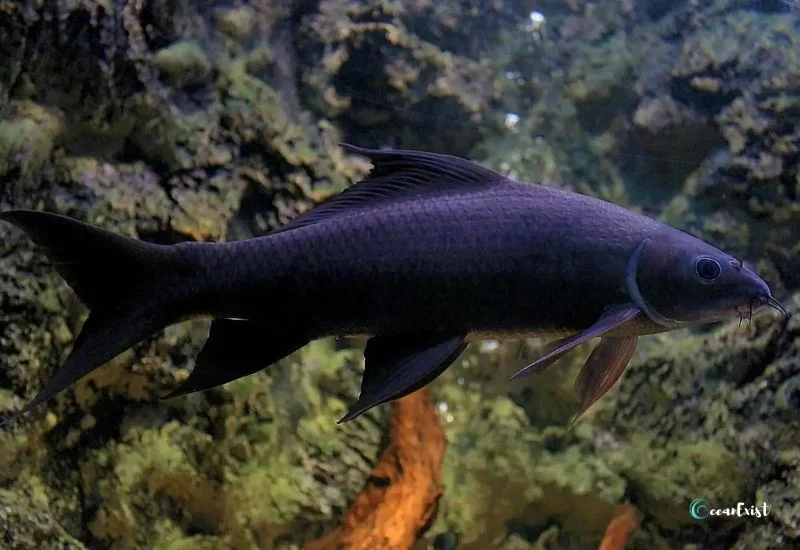
The black shark is one of the largest freshwater sharks. They can grow up to 2-3 meters in size if you provide them with optimal water conditions and feed them a rich protein diet.
They are very aggressive and territorial. They require a larger tank area for swimming freely.
They should not be housed with other species due to their aggressive nature. But we have experience keeping them with other fish species of the same nature.
- Scientific name: Labeo chrysophekadion
- Size: 24 inches
- Food and Diet: Omnivores/bloodworms, dry flakes
- Temperament: Aggressive to smaller fish
- Lifespan: 10 years
- Origin: Malaysia
- Required Tank Size: 125 Gallons
- Difficulty to breed: Intermediate
- Temperature: 68-79° Fahrenheit
- Water pH: 6.0-8.0
- Water Hardness: 10-16 dGH
Roseline Shark

Rolseine shark is very popular among aquarists due to its vivid colouring and appearance. Roseline sharks are also known as Roseline Torpedo or Denison Barb.
They have a silver-colored body with a black stripe from their head to tail. There is a red stripe covering the half body starting from its eye.
They are community fish and need to be kept in a group of 5-6 Roseline sharks. They can grow up to 4-5 inches in size. So, You can house them in a small aquarium.
- Scientific name: Sahyadria denisonii
- Size: 4-5 inches
- Food and Diet: Omnivores / live fish or frozen foods
- Temperament: Aggressive / Territorial
- Lifespan: 4-5 years
- Origin: Western Ghats in India
- Required Tank Size: 50 Gallons
- Difficulty to breed: Beginner
- Temperature: 68-79° Fahrenheit
- Water pH: 6.5-7.8
- Water Hardness: 5-25 dGH
Siamese Algae Eater
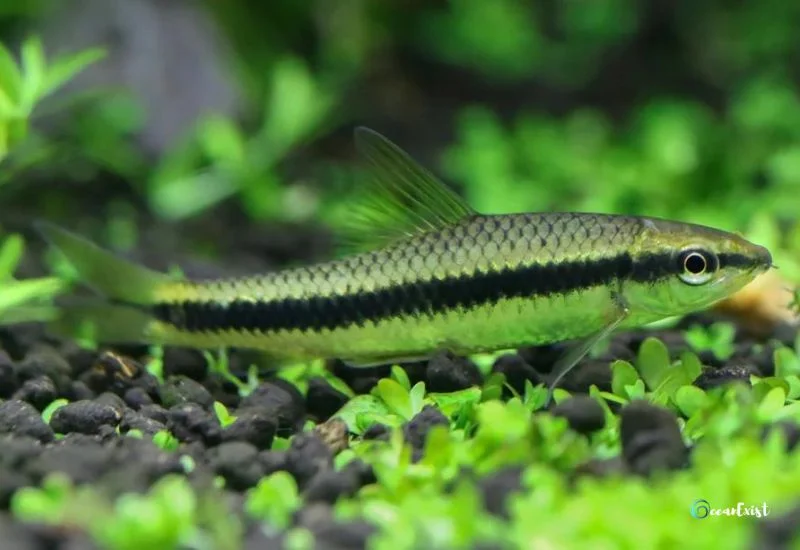
Siamese Algae Eater (SAE) is one of the fish which can eat brown algae. It is mostly kept because algae are eaten and the aquarium is cleaned. SAE has a silver-brown body with a black line from its head to its tail.
SAEs come from the tropical areas of southeast Asia. They are habitual of living in hot water temperatures with slightly high pH nearest to neutral.
You will observe their aggressive and territorial behavior towards their own species and other fish species. They usually do this when they are getting old.
- Scientific name: Crossocheilus oblongus
- Size: 6 inches
- Food and Diet: Frozen fish foods, flakes and wafers
- Temperament: Peaceful
- Lifespan: 10 years
- Origin: Southeast Asia
- Required Tank Size: 50 Gallons
- Difficulty to breed: Beginner
- Temperature: 72–79° Fahrenheit
- Water pH: 6.0-8.0
- Water Hardness: 5-20 dGH
Chinese High-Fin Banded

The Chinese High-Fin band is also known as the Chinese Sukerfish. They have a beautiful appearance and black and white stripes on their body. These strips become darker, and their shape changes when they grow old.
These chinese High-fin banded sharks can grow up to 24 inches long which is why they require a larger tank size.
This shark fish is mostly kept in outdoor aquariums due to their larger size. They require a good water flow and highly oxygenated aquatic condition to thrive.
- Scientific name: Myxocyprinus asiaticus
- Size: 24 inches
- Food and Diet: small live and frozen fish foods
- Temperament: Peaceful
- Lifespan: 25 years
- Origin: Yangtze River basin of China
- Required Tank Size: 300 Gallons
- Difficulty to breed: Difficult
- Temperature: 55° Fahrenheit
- Water pH: 6.8-7.5
- Water Hardness: 10-20 dGH
Harlequin Shark
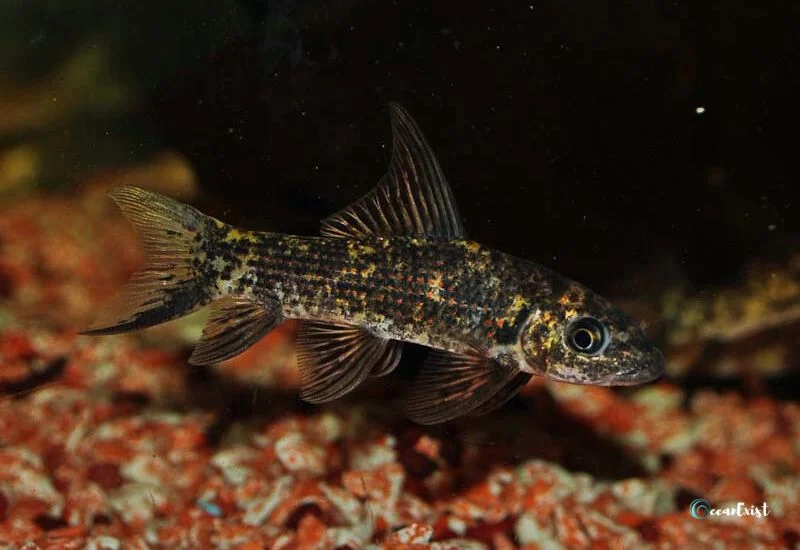
The Harlequin sharks are very beautiful and solitary freshwater fish. They are very territorial fish and cannot be kept with other species. They tend to be more aggressive against smaller species.
Suppose you want to house other species in the aquarium, place fish which live mostly on water surfaces. Because Harlequin sharks are bottom-dwelling fish.
You will need to provide more hiding places in the aquarium. You can grow plants and place small stones in their hiding places.
- Scientific name: Labeo cyclorhynchus
- Size: 6 inches
- Food and Diet: omnivores/microfauna and algae
- Temperament: Territorial
- Lifespan: 25 years
- Origin: Central Africa
- Required Tank Size: 40 Gallons
- Difficulty to breed: Intermediate
- Temperature: 55° Fahrenheit
- Water pH: 6.8-7.5
- Water Hardness: 10-20 dGH
Iridescent Shark
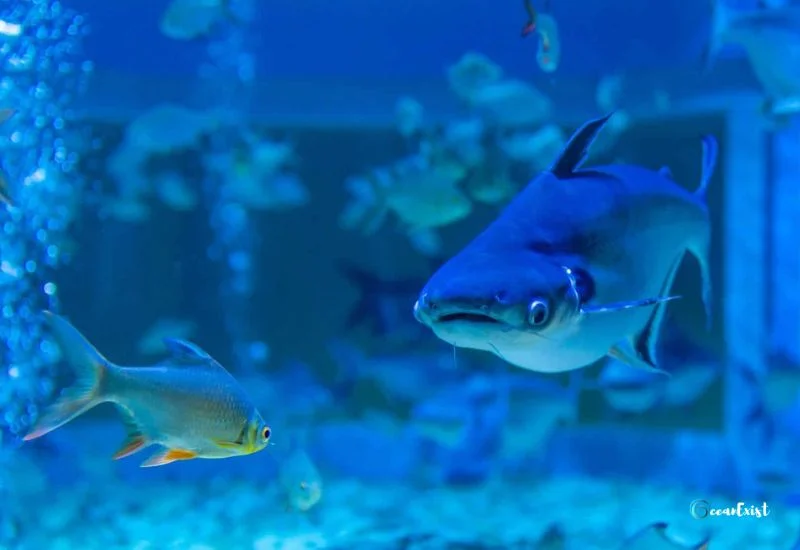
The Iridescent sharks are very long in size fish and have an average lifespan of almost 20 years. When they are young, they have radiated and glowy skin. Their coloring starts darkening with the passing age.
They have very charming freshwater fish and catfish-like heads, which is why they are also known as Iridescent Catfish Sharks.
They eat a variety of food to balance the proportions of nutrients in their body. They need a larger tank size with high temperature and moderate pH levels.
- Scientific name: Pangasianodon hypophthalmus
- Size: 36-48 inches
- Food and Diet: Flake, pellet food, and brine shrimp
- Temperament: Peaceful
- Lifespan: 20 years
- Origin: Chao Phraya and Mekong in Asia
- Required Tank Size: 300 Gallons
- Difficulty to breed: Expert
- Temperature: 72-79° Fahrenheit
- Water pH: 6.5-7.5
- Water Hardness: 2-29 dGH
Violet Blushing Shark
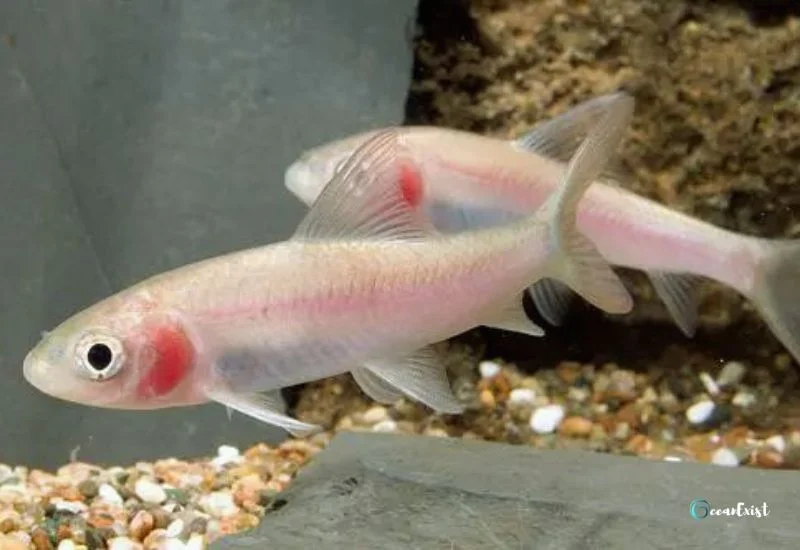
The Violet Blushing Shark has a very unique appearance. You will observe a soft luster on their bodies when they are underwater.
They are very peaceful fish that do well in the form of community. You should not place them with smaller species because they may consider them to be their food. But medium-sized fish prove to be ideal tank mates.
The fish can grow up to 12 inches in size. They require a tank of size equal to 130 gallons.
- Scientific name: Labeo boga
- Size: 12 inches
- Food and Diet: Frozen and live food, bloodworms and Tubifex
- Temperament: Peaceful
- Lifespan: 10 years
- Origin: Western Ghats of India, Nepal
- Required Tank Size: 130 Gallons
- Difficulty to breed: Intermediate
- Temperature: 68-78° Fahrenheit
- Water pH: 6.0-7.5
- Water Hardness: 2– 15 dGH
Silver Apollo Shark
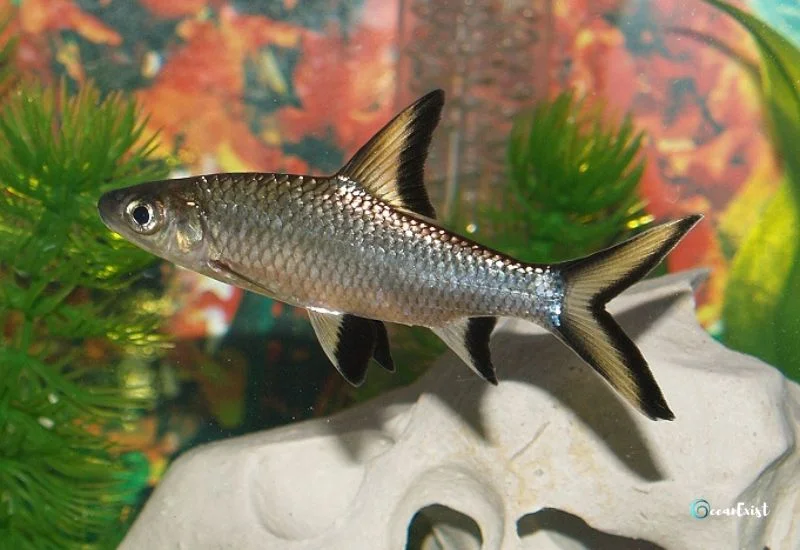
The Silver Apollo shark is a unique freshwater fish with a silver and gold-colored body. It has brown colored stripes on its body.
They are very active and schooling fish and need to be kept in a group of 5-6 fish in an aquarium.
They have a very fast growth rate and need to be placed in a tank of almost 125 gallons. The young Silver Apollo shark can grow up to 6 inches in size, and this size may go to 9 inches in their adulthood.
- Scientific name: Luciosoma setigerum
- Size: 6-9 inches
- Food and Diet: brine shrimps, bloodworms and larvae
- Temperament: Peaceful
- Lifespan: 10 years
- Origin: Cambodia, Indonesia, and Malaysia
- Required Tank Size: 125 Gallons
- Difficulty to breed: Intermediate
- Temperature: 72-80° Fahrenheit
- Water pH: 6.0-7.8
- Water Hardness: 5– 12 dGH
Cosmic-Blue Glo
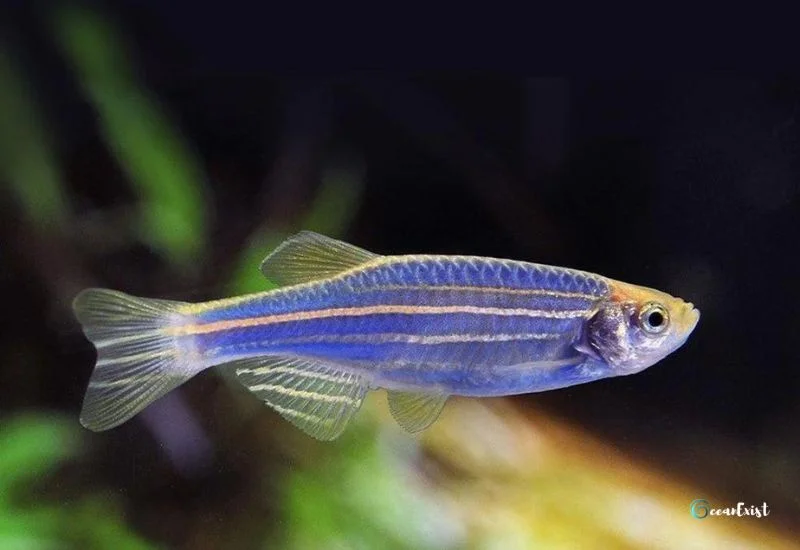
The Cosmic-Blue Glo is known for its existence by the genetic modification of scientists. This modification was done to diagnose the aquatic toxins. But, this is now more popular as it is among the best choices for aquarists.
It is a neon-blue color version of Rainbow Shark. The Cosmic-Blue Glo has no specific aquarium requirements. You can keep it like any other water fish with moderate pH and water conditions.
- Scientific name: Gymnocorymbus ternetzi
- Size: 6.3 cm
- Food and Diet: flakes and pellet food
- Temperament: Semi-aggressive
- Lifespan: 3.5-5 years
- Origin: Aquacultured
- Required Tank Size: 20 Gallons
- Difficulty to breed: Beginner
- Temperature: 75-80° Fahrenheit
- Water pH: 6.5-7.5
- Water Hardness: Ideal
Galactic Purple Glofish
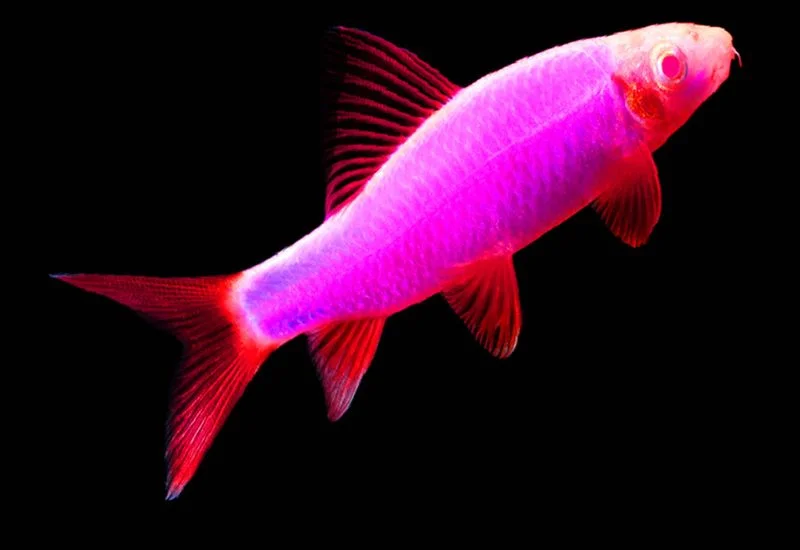
The Galactic Purple Goldfish is a light pink/purple colored fish with a white face and red eyes. This is known to be the color variation of the Rainbow shark. This shark goldfish is very popular among aquarists who are looking for vividly colored fish.
The Galactic Purple fish is the best choice for beginner aquarists for its ease of care. They are very peaceful schooling fish and are considered to be kept in a community of 8-10 fish of similar species.
- Scientific name: Epalzeorhynchos frenatum
- Size: 2 inches
- Food and Diet: flakes, pellet food, and brine shrimp
- Temperament: Semi-aggressive
- Lifespan: 4+ years
- Origin: Thailand and Cambodia
- Required Tank Size: 7-20 Gallons
- Difficulty to breed: Advanced
- Temperature: 68-79° Fahrenheit
- Water pH: 6.5-8
- Water Hardness: Moderate
Columbian Shark
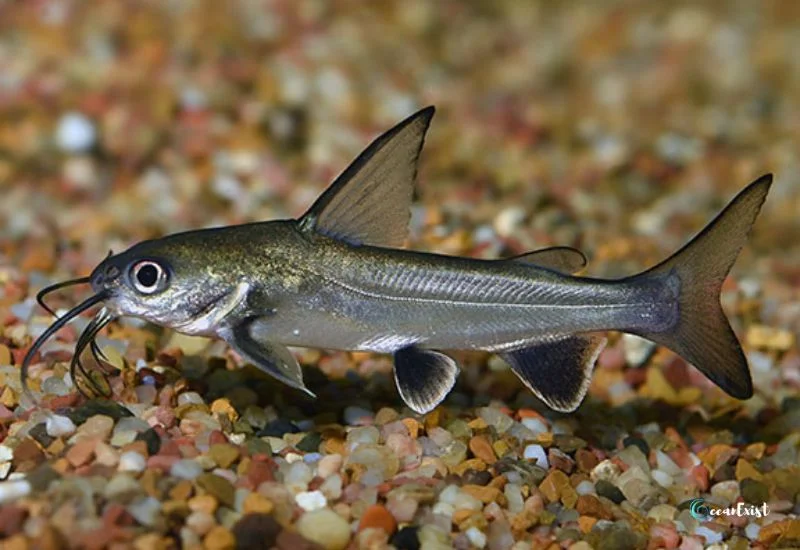
The Columbian shark is a very sleek and silvery catfish. They have very long fins and whiskers, which is why they are also known as West American cat sharks.
The Columbian sharks are not very true freshwater fish. But, this fish starts its initial journey in freshwater. Then, it starts moving towards brackish or salty water as in its adulthood.
These fish are not recommended to beginner aquarists as they are not community freshwater fish. They are not very aggressive fish, but they may predate smaller fish. So, they should not be placed with smaller fish.
These fish have venomous spines, which may cause injuries to other fish if placed in a group.
- Scientific name: Ariopsis seemanni
- Size: 10-12 inches
- Food and Diet: omnivores/flakes, pellet food and bloodworms
- Temperament: Peaceful
- Lifespan: 4+ years
- Origin: Central and South America
- Required Tank Size: 150 Gallons
- Difficulty to breed: Advanced
- Temperature: 74-79° Fahrenheit
- Water pH: 7-7.5
- Water Hardness: 10-12 KH
Albino Rainbow
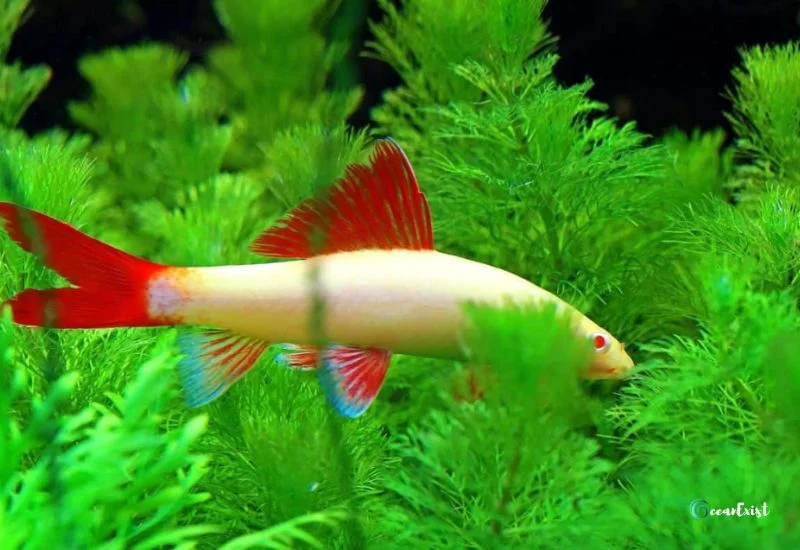
The Albino Rainbow is one of the most popular aquarium fish due to its coloration variation, stunning personality, and bright red fins.
Due to its coloration and vivid activities in the aquarium, it is known as a minnow. It spends most of its time eating small proportions of algae and small organisms in the bottom water layer.
These fish may get aggressive and territorial towards other small fish in their adulthood.
- Scientific name: Epalzeorhynchos frenatum
- Size: 4 inches
- Food and Diet: omnivores
- Temperament: Peaceful/aggressive at adulthood
- Lifespan: 4–6 years
- Origin: basins of Thailand, Cambodia, and Laos
- Required Tank Size: 70 Gallons
- Difficulty to breed: Advanced
- Temperature: 68-79° Fahrenheit
- Water pH: 6.5-8
- Water Hardness: 2-15 dKH
Flying Fox
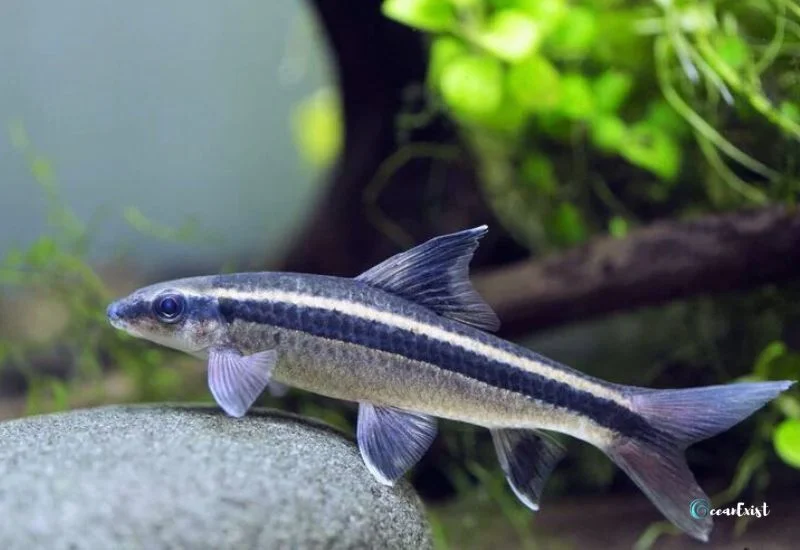
The Flying Fox is a great algae eater and freshwater fish. They are community fish as long as they are kept with other Flying Fox or similar species like red-tailed sharks.
The Flying Fox is not actually a shark but a true freshwater fish. They have triangular-shaped dorsal fins and stretched-out bodies, which is why it is called a shark.
They eat diverse food which includes a mixture of vegetable, plant based food and other rich protein diets such as bloodworms, brine shrimps and small insects.
- Scientific name: Epalzeorhynchos kalopterum
- Size: 6 inches
- Food and Diet: omnivores / Algae eater
- Temperament: Semi-aggressive
- Lifespan: 12-15 years
- Origin: basins of Thailand, Cambodia, and Laos
- Required Tank Size: 65 Gallons
- Difficulty to breed: Advanced
- Temperature: 68-79° Fahrenheit
- Water pH: 6-7.5
- Water Hardness: 2-12 dKH
Paroon shark

The Paroon shark or giant Pengasius is a popular freshwater species of the Pangasiidae family. This fish originated from the Mekong and Chao Phraya rivers flowing in China and Thailand.
The Paroon shark is sensitive to water quality and surrounding conditions. It mostly lives in the bottom freshwater of rivers. This fish is known for its astounding appearance. It has a sleek body with dark spots and vertical bars all over the body.
Paroon sharks are carnivores and mostly feed on brine shrimps, small fish, and animal carcasses at the water bottoms.
- Scientific name: Pangasius sanitwongsei
- Size: 100 inches
- Food and Diet: small fish, plants, and animal carcasses
- Temperament: Aggressive
- Lifespan: 20 years
- Origin: Chao Phraya and Mekong basins in Indochina
- Required Tank Size: 6600 Gallons
- Difficulty to breed: Advanced
- Temperature: 74-79° Fahrenheit
- Water pH: 7-7.5
- Water Hardness: 10-12 dKH
Conclusion
In conclusion, freshwater sharks are very colorful, amusing personalities and community fish. But, it is important to know the specific needs of each freshwater shark. They have varied food diets and require specific water conditions, temperature, and pH, which We have covered in the article above.
If you have any queries related to this topic, you can ask us in the comments. Read our next topic on “Types of Freshwater Eels.”
